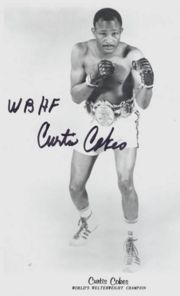By: Jim Amato

He may have been one of the best pound for pound boxers of the 1960’s but he was over shadowed by the antics of one Cassius Clay / Muhammad Ali. He may have been the best fighter in the welterweight division during the decade but he never had a chance to prove it against Emile Griffith. Instead he labored in the back round, fighting and beating all comers. Only after Griffith moved up to middleweight and allowed him to capture the vacated title did Curtis Cokes gain some long over due recognition.
Curtis who never had an amateur fight began his professional career in Midland, Texas on March 24, 1958 outscoring Manuel Gonzalez over six rounds. Curtis and Manuel would get to know each other a lot better in years to come.Curtis was born on June 15, 1937 in Dallas, Texas. He would go on to win his next ten fights including an eight rounder over Gonzalez. Finally in April of 1959, one year after turning pro Curtis suffered his first career loss to none other then Manuel Gonzalez. A no contest in a match with the talented Rip Randall set up a rematch. Curtis took out Randall in the first round. Later in the year Curtis would drop a six round duke to Frankie Davis.
Cokes won four fights in 1960. In 1961 he moved up the ladder with big wins over Joe Miceli and Charley ” Tombstone ” Smith. Cokes then dropped a decision in Mexico to Hilario Morales.He then fought a draw with the clever Kenny Lane in Dallas. Back in Dallas two months later Curtis scored a huge win with a split decision over the highly respected Luis Rodriguez. Cokes would then meet and again decision Manny Gonzalez but would lose a points call to Rodriguez in a return match.
Curtis would bounce back in 1962 with five straight wins including knockouts over Hilario Morales and the rugged Rudolph Bent. Another trip to Mexico cost him another defeat. This time a decision to Manuel Sixto Alvarez. Four more wins led to a 1963 clash at the Sunnyside Garden in New York against contender Jose Stable. Curtis lost a very close decision. Cokes would then outpoint the very tough Stan Harrington. On May 1, 1964 Curtis travelled to the Blue Horizon in Philadelphia to meet the dangerous Stan ” Kitten ” Hayward. He would suffer a major set back as Hayward stopped Cokes in round four.
It was back to the drawing board for Curtis. Two decision wins over Al Andrews got him back on track but he dropped a ten rounder to the slick Eddie Pace. On December 13, 1965 Curtis won the Southern Welterweight title with a twelve round decision over Billy Collins. On July 6, 1966 Cokes stopped Luis Rodriguez one minute in to the fifteenth and final round of an eliminination bout for the welterweight title vacated by Emile Griffith.
Seven weeks after his win over Rodriguez, Cokes met old rival Manuel Gonzalez for the WBA version of the welterweight title. The battle took place in New Orleans. Curtis floored Gonzalez on his way to a lopsided decision and a world’s championship. In November Cokes outclassed Frenchman Jean Josselin to win universal recognition as welterweight champion. Still many felt that Cokes was the champ only because Griffith had vacated the division. Curtis would go on to prove himself a worthy champion.
In early 1967 Curtis would have three non title affairs. First he drew with Francious Pavilla. He knocked out Ted Whitfield but then Curtis was outpointed by the wily Gypsy Joe Harris. Finally Cokes defended his title halting Pavilla in a return bout. Next came a very impressive stoppage of sharp contender Charlie Shipes. Two non title wins in early 1968 over Josselin and Jimmy Lester led to a defense in Dallas against South African contender Willie Ludick. An inspired Cokes flattened Ludick in the fifth round. Three non title knockouts in South Africa followed including a repeat performance over Ludick. Then came a one sided title retaining verdict over Ramon La Cruz.
Jose Napoles, a Cuban who had migrated to Mexico years before had long been considered one of the best fighters in the business. Still he had never received a shot at a world title. Curtis Cokes was a proud man and a proud champion. He felt he was the best welterweight in the world. He also knew that Napoles was a very worthy contender and that he deserved a shot at the title. They met at the Forum in Inglewood, California on April 18, 1969. On that day Napoles proved to the world that he was a special fighter. Jose out fought and battered the game Cokes throughout using a remarkable jab and bone jarring combinations. Hopelessly behind on points Curtis did not answer the bell for round fourteen and his belt was awarded to Napoles.
Maybe it was just a bad night but Curtis had to know so he went down to Mexico two months later to attempt to reclaim his championship. Again Napoles proved to be too much for the game Cokes and the bout was ended after ten rounds. Curtis would return seven months later as a full fledged middleweight. Cokes had hoped that old rival Luis Rodriguez would defeat middleweight king Nino Benvenuti when they met on November 22, 1969. Curtis was confident that Rodriguez would give him a crack at the middleweight title. After ten rounds Rodriguez had Benvenuti bleeding and bewildered and it looked like Luis was going to take the crown and then just like that, it was over. A crashing left hook put Rodriguez flat on his back for the count as the bleeding Benvenuti retained his crown.
With little hope of a title shot Curtis still campaigned as a middleweight. He won four bouts but then drew with Akron’s Fate Davis, a fighter he he defeated seven months earlier. Cokes then lost decisions to Rafael Gutierrez and Carlos Salinas on the West Coast. Then he lost to Elijah Makathini in South Africa. By now it was 1972 and Carlos Monzon was firmly entrenched as middleweight king. There would be little interest in a bout between the great Monzon and the aging Cokes. Curtis returned to South Africa and won decisions over Joseph Hali and Ezra Mzinyane and then retired.
In 80 bouts Curtis put together a fine 62-14-3 record with one no contest. He won thirty fights by knockout. He was stopped only three times. He met the best welterweights of his era other then Emile Griffith.Curtis was inducted into the International Boxing Hall Of Fame in 2003 With the help of mutual friend Steve Canton, I was able to reach Mr. Cokes and have a very nice conversation with him. I contacted him at his gym where he trains boxers. Curtis once trained highly regarded heavyweights Ike Ibeabuchi and Kirk Johnson. He also guided Quincy Taylor to the middleweight title. He also appeared in the boxing movie classic ” Fat City “.
Curtis was extremely courteous and giving with his time. He said even though he and Manny Gonzalez met in the ring numerous times, they were very good friends. Curtis had a tremendous amount of respect for Luis Rodriguez and despite their battles they always maintained a friendly relationship. I asked him if he regretted never meeting Emile Griffith in the ring. Curtis more or less said that he had no control on Emile’s decision to move up in weight. Did he feel he could have defeated Emile ? In his low key, respectful manner Mr.Cokes just stated he felt that he was capable of beating any welterweight in the world during his prime but he had a great respect for Emile’s talent and that they are friends. He said the knockout loss to Stan Hayward in 1964 took him by surprise but he just put it behind him and moved on. He called Napoles a great fighter who he was just unable to overcome. Curtis really felt that if Rodriguez would have defeated Benvenuti, they would have met again. This time for the middleweight championship of the world.
I would like to thank Curtis Cokes for taking the time to speak to me one on one. I’d also like to thank promoter, trainer, gym owner and jack of all trades Steve Canton for helping me to contact Curtis.


